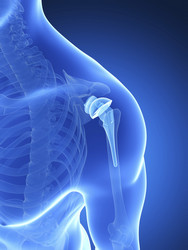Better joint implants for osteoarthritis
Osteoarthritis (OA) is the most common musculoskeletal disorder affecting hundreds of millions of people globally. Currently, there is no definitive cure for OA and treatment usually involves total joint replacement. The success of this method depends on the rapid and complete biological integration of the prosthetic device with the existing bone, a process known as osseointegration. So far, hydroxyapatite has been used in coating prosthetic implants, but it often fails during long-term implantation and may result in osteolysis. The EU-funded BIOSTEM (The development of biologically active metal implants for improved osseointegration) project aimed to develop biologically active metal implants for improved osseointegration after joint arthroplasty procedures. To address coating issues in implants, BIOSTEM proposed to deliver collagen onto the surface of poly-(ether-ether)-ketone (PEEK). PEEK is a biologically inert clinical polymer that has had significant clinical success in spinal and craniomaxillofacial applications. Researchers successfully modified collagen for coating PEEK to facilitate bone apposition while retaining desired chemistry as assessed by spectroscopy methods. Additionally, the hybrid material increased the attachment of mesenchymal stem cells and their osteogenic differentiation. Moreover, the plasma device used for implant coating could easily be housed in hospitals for on-site fabrication. The BIOSTEM approach was validated in an in vivo preclinical rabbit model with femur PEEK implants. A series of methods were utilised such as mechanical testing, histomorphometric analyses and micro-computed tomography to assess bone volume at the implant interface. Overall, the BIOSTEM approach addresses current limitations in the field of prosthetics related to implant coatings. It provides a clinically viable, long-term and stable modification of PEEK that has the potential to facilitate osseointegration in OA patients.
Keywords
Osteoarthritis, joint replacement, osseointegration, collagen, PEEK

